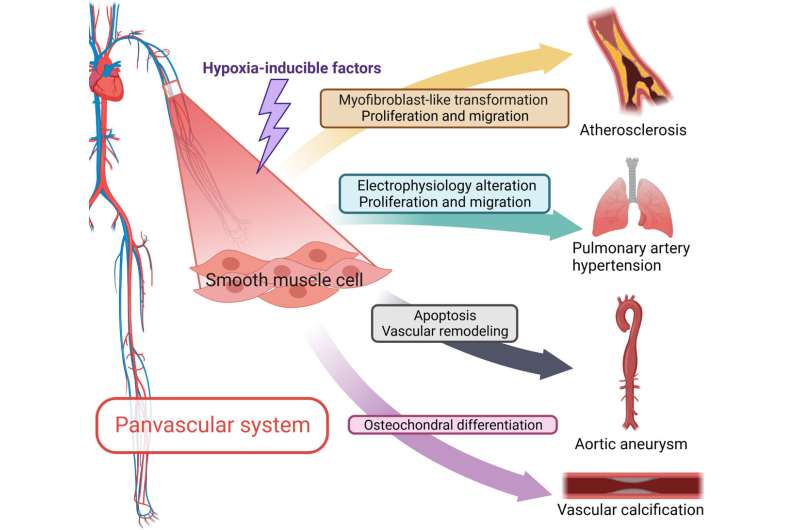This article has been reviewed according to Science X's editorial process and policies. Editors have highlighted the following attributes while ensuring the content's credibility:
fact-checked
trusted source
proofread
Exploring the role of hypoxia-inducible factors in vascular smooth muscle cells under panvascular pathologies

As an emerging concept, panvascular diseases encompass a group of cardiovascular disorders characterized mainly by atherosclerosis, involving crucial organs such as the heart, brain, kidneys, and limbs. Hypoxia-inducible factor (HIF) plays a pivotal role as a major regulatory factor in the cardiovascular system's response to common stressors, such as hypoxia.
Meanwhile, vascular smooth muscle cells (VSMCs) serve as key cells responsible for regulating cardiovascular system pressure and oxygen delivery. The plasticity, versatility, and interaction of these two factors with panvascular diseases warrant in-depth investigation.
In the pathological state of panvascular diseases, overactive VSMCs (e.g., in atherosclerosis, pulmonary arterial hypertension) or dysfunctional VSMCs (e.g., in arterial aneurysms, vascular calcification) are closely associated with HIFs. These widespread systemic diseases also underscore the interdisciplinary nature of panvascular medicine.
Furthermore, considering the similarities in proliferative characteristics between VSMCs and cancer cells, as well as the delicate balance between angiogenesis and cancer progression, there is an urgent need for more precise regulatory targets or combination therapies to enhance the effectiveness of HIF-targeted treatments.
Based on the above content, this review focuses on discussing the significance of the HIF signaling pathway in panvascular diseases related to VSMCs, taking into consideration the importance of balancing global and local, as well as temporal and spatial aspects.
The review also explored the relevance of HIF-related drugs' targets in panvascular diseases while weighing their pros and cons. The "-dustats" is a novel type of drug that can inhibit PHD, thus activating the HIF-EPO pathway, and its effect on increasing EPO in the body is gentle. In existing research, the drug "-dustats" has been found to improve iron metabolism while treating anemia, and it generally does not exhibit significant cardiovascular side effects or promote cancer occurrence.
Furthermore, more precise and targeted HIF pathway-activating drugs require either more specific indirect activation of HIF (e.g., inhibitors targeting specific PHD1-3 or FIH) or more effective direct activation targeting the specific HIF isoforms. Additionally, the issue of drug resistance also needs to be addressed.
Collectively, there are three key points in advancing the transformation of HIF-related treatment strategies for VSMC in panvascular medicine:
(1) focusing on the commonality and specificity of HIFs in panvascular disease;
(2) the overall consideration of targeting HIF-related pathways, and
(3) the development of precise drugs targeting HIF-related pathways.
Overall, the clinical transformation of HIFs-related therapies requires that doctors pay more attention to individual differences (e.g., place of residence, gender, and disease) in diagnosis and treatment to identify underlying problems; researchers explore and clarify the different roles and interactions of HIFs in different organs/systems or different stages of the disease; and pharmaceutical experts or engineers strive to industrialize the production of personalized targeted drugs with superior pharmacodynamics and pharmacokinetics.
Therefore, based on the principle of "from doctors, by engineers/researchers, for patients," the substantial clinical transformation of HIFs-related treatment in panvascular medicine can be realized.
The research is published in the journal Science Bulletin. This study was led by Prof. Junbo Ge (Department of Cardiology, Zhongshan Hospital, Fudan University, Shanghai Institute of Cardiovascular Diseases), Prof. Hua Li (Department of Cardiology, Zhongshan Hospital, Fudan University, Shanghai Institute of Cardiovascular Diseases), and Prof. Hao Lu (Department of Cardiology, Zhongshan Hospital, Fudan University, Shanghai Institute of Cardiovascular Diseases).
More information: Yiqing Hu et al, Hypoxia and panvascular diseases: exploring the role of hypoxia-inducible factors in vascular smooth muscle cells under panvascular pathologies, Science Bulletin (2023). DOI: 10.1016/j.scib.2023.07.032





















